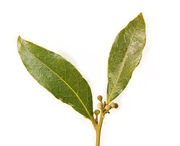Bay Laurel
| Bay Laurel | |
|---|---|
 |
|
| Bay Laurel (Laurus nobilis) flower buds and leaves | |
| Scientific classification | |
| Kingdom: | Plantae |
| (unranked): | Angiosperms |
| (unranked): | Magnoliids |
| Order: | Laurales |
| Family: | Lauraceae |
| Genus: | Laurus |
| Species: | L. nobilis |
| Binomial name | |
| Laurus nobilis L. |
|
The Bay Laurel (Laurus nobilis, Lauraceae), also known as True Laurel, Sweet Bay, Laurel Tree, Grecian Laurel, Laurel, or Bay Tree, is an aromatic evergreen tree or large shrub reaching 10–18 metres (33–59 ft) tall, native to the Mediterranean region.
Contents |
Growth
The leaves are 6–12 cm long and 2–4 cm broad, with a characteristic finely serrated and wrinkled margin. It is dioecious, with male and female flowers on separate plants; each flower is pale yellow-green, about 1 cm diameter, borne in pairs together beside a leaf. The fruit is a small black berry about 1 cm long, containing a single seed.
Uses and symbolism
Bay Laurel is the source of the bay leaves, which are used for their flavour in cooking. It was also the source of the laurel wreath of ancient Greece, and therefore the expression of "resting on one's laurels". A wreath of bay laurels was given as the prize at the Pythian Games because the games were in honor of Apollo, and the laurel was one of his symbols ever since his unsuccessful pursuit of Daphne. In the Bible, the sweet-bay is often an emblem of prosperity and fame. In Christianity, it symbolizes the Resurrection of Christ and the triumph of Humanity thereby. It is also the source of the word baccalaureate (laurel berry), and of poet laureate.
In Chinese folklore, there is a great laurel tree on the moon, and the Chinese name for the laurel, (traditional Chinese: 月桂), literally translates to "moon-laurel". This is the subject of a story of Wu Gang, a man who aspired to immortality and neglected his work. When the deities discovered this, they sentenced Wu Gang to fell the laurel tree, whereupon he could join the ranks of the deities; however, since the laurel regenerated immediately when cut, it could never be felled. The phrase (simplified Chinese: 吴刚伐木) ("Wu Gang chops the tree") is sometimes used to refer to endless toil, analogous to the legend of Sisyphus in Greek mythology.
The aromatic laurel leaves are used in many countries of central and southern Europe to flavour stews, soups, meat dishes, and even fish. They are used to season canned cucumbers or herring, or added to give aroma to vinegar.
It is also widely cultivated as an ornamental plant in regions with mediterranean or oceanic climates, and as an indoor plant in colder regions.
Bay leaves are eaten by the caterpillars of some lepidopterans, for example the Eastern tiger swallowtail (Papilio glaucus).
Chemical constituents
In the fruit, there are essential oils and fatty oils present. The fruit is pressed and water extracted to obtain these products. The fruit contains up to 30% fatty oils and about 1% essential oils (terpenes, sesquiterpenes, alcohols, and ketones).
The leaves contain about 1.3% essential oils (Ol. Lauri folii), consisting of 45% eucalyptol, 12% terpenes, 3-4% sesquiterpenes, 3% methyleugenol, and other α- und β-pinenes, phellandrene, linalool, geraniol, and terpineol.
Gallery
 thumb|A Laureltree senn on the islan of Terceira |
Flowers and leaves |
 |
 Flower buds |
 Bay Laurel grown in a kitchen for bay leaves |
 19th century illustration |
 Scale insect under a bay leaf |
A Laurus nobilis bush. |
|
A close-up of several Laurus nobilis leaves. |
Miscellaneous Information
- The leaf and berries of Bay Laurel are on the U.S. one-dollar bill: in particular, on the obverse, two bunches of bay laurel leaves with berries prop up the oval, which contains George Washington.
- Bay laurel leaves are used in the design of the 10-yen coin in Japan.
- In Greek mythology, the tree was first formed when the nymph Daphne changed into it to escape the lustful pursuit of the Olympian god Apollo; see Apollo and Daphne. Daphne is the Greek name for the tree.
- The National Emblem of Greece consists of a blue escutcheon with a white cross totally surrounded by two laurel branches.
- The Scottish Clan Graham considers this plant to be its clan plant.
- The shield on the Flag of the Dominican Republic consists of one bay laurel and one palm.
Externals
Examples of biological activity
Examples of biological activity of Bay laurel:
- Simić M, Kundaković T, Kovacević N (September 2003). "Preliminary assay on the antioxidative activity of Laurus nobilis extracts". Fitoterapia 74 (6): 613–6. doi:10.1016/S0367-326X(03)00143-6. PMID 12946729. http://linkinghub.elsevier.com/retrieve/pii/S0367326X03001436.
- Sayyah M, Saroukhani G, Peirovi A, Kamalinejad M (August 2003). "Analgesic and anti-inflammatory activity of the leaf essential oil of Laurus nobilis Linn". Phytother Res 17 (7): 733–6. doi:10.1002/ptr.1197. PMID 12916069.
- Sayyah M, Valizadeh J, Kamalinejad M (April 2002). "Anticonvulsant activity of the leaf essential oil of Laurus nobilis against pentylenetetrazole- and maximal electroshock-induced seizures". Phytomedicine 9 (3): 212–6. doi:10.1078/0944-7113-00113. PMID 12046861.
External links
- MeSH: Laurus - Laurus nobilis (Bay Laurel)
- MeSH: 3-oxo-eudesma-1,4(15),11(13)triene-12,6alpha-olide [Substance Name]
- MeSH: anhydroperoxycostunolide [Substance Name]
- MeSH: magnolialide [Substance Name]
- PubMed search: "Laurus"[MAJR]
- PubMed search: "anhydroperoxycostunolide" OR "magnolialide" OR "3-oxo-eudesma-1,4(15),11(13)triene-12,6alpha-olide"
- "All Natural.Net - Encyclopedia of Herbs"
- "Graham Clan Website"
|
||||||||||||||||||||||||||||||||||||||||||